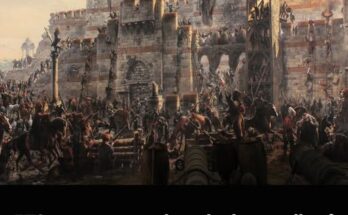
War has never been only about firepower. Behind every battlefront lies a shadow war—a war of misinformation, misdirection, and mental manipulation. Among the countless tales of World War II, one story stands out for its brilliance, simplicity, and irony: the Germans, in a masterful attempt at deception, constructed a fake airfield complete with wooden aircraft, wooden hangars, and wooden vehicles. The British Royal Air Force (RAF), fully aware of the charade, allowed it to be completed before dropping a single wooden bomb in reply.
Though brief in action, the incident has echoed through history as a potent symbol of psychological warfare and wartime intelligence. Whether entirely true or embellished with time, the wooden bomb tale captures the imagination and reminds us that in war, sometimes the sharpest weapon is wit.
Chapter 1: The Age of Deception
Military deception has been a fundamental strategy since the earliest wars. From the legendary Trojan Horse to Sun Tzu’s Art of War, misleading the enemy has often determined victory as much as weaponry. By World War II, deception had become a sophisticated science involving intelligence agencies, aerial photography, double agents, and entire units dedicated to illusion.
Both the Axis and Allied powers used fake equipment, misleading signals, and decoy installations to misdirect enemy forces. These tactics weren’t just diversions—they were complex psychological tools designed to waste enemy resources, delay actions, and sow confusion. In this context, the Germans’ fake airfield was not an anomaly but part of a broader strategy.
Chapter 2: The German Wooden Airfield
Sometime during World War II, the German Luftwaffe is said to have undertaken the construction of a decoy airfield. Details vary—some sources cite locations in France, others in Belgium or Holland—but the core of the story remains consistent.
The airfield was created to deceive Allied reconnaissance and bombing raids. Using plywood, canvas, and other light materials, the Germans constructed what appeared from the sky to be a fully operational base. Fake aircraft were parked in position, wooden fuel trucks were scattered about, and control towers and hangars mimicked real ones in shape and shadow.
The intention was clear: if Allied bombers spotted the airfield from above, they would attack the decoy instead of real strategic targets. This would allow German forces to preserve their actual bases and equipment, buying time and space to continue their operations unimpeded.
The Germans even went so far as to simulate activity. Men moved about the airfield, vehicles (or at least mock-ups) were shifted around, and in some versions, fake radio transmissions were sent out. It was an ambitious ruse that took weeks, if not months, to complete.
Chapter 3: British Intelligence – The Silent Observers
Unbeknownst to the Germans, British intelligence had already discovered the operation early in its development. Through aerial reconnaissance, signal intercepts, and local informants, the RAF knew the airfield was a decoy long before its completion.
The Allies had their own formidable deception operations, and they understood the importance of managing perception. But what makes the wooden bomb story stand out is the elegance of the British response. Rather than attack the airfield and thereby validate its purpose, they chose patience.
The RAF waited. They watched the wooden base take shape. They allowed the Germans to invest time, labor, and resources into a structure that would never fool them. And then, at the right moment, a British plane reportedly flew over the completed decoy and dropped a single bomb.
Not a real bomb—but a wooden bomb.
Chapter 4: The Wooden Bomb – Message Delivered
The wooden bomb was more than just a prank. It was a calculated psychological strike. By dropping a fake bomb on a fake airfield, the RAF sent a devastating message: “We know. You failed. We were always one step ahead.”
Imagine the reaction on the ground. German soldiers and engineers, having spent weeks constructing a phantom base, would have looked up to see not destruction—but mockery. The wooden bomb didn’t explode, but it detonated egos, embarrassed commanders, and rendered the entire effort farcical.
Such an act demonstrated several things:
- That British intelligence was active and capable.
- That Allied reconnaissance could penetrate German defenses without being detected.
- That the Luftwaffe’s efforts were not just ineffective—but laughable.
This was warfare as theater. The message was loud, clear, and humiliating: “Nice try.”
Chapter 5: Is It True? Fact vs. Legend
Historians have long debated the factual accuracy of the wooden bomb story. The tale has been repeated in memoirs, newspapers, and even military lectures. Yet hard documentation—photographs, official RAF mission logs, or German reports—is elusive.
There are plausible reasons for this. Many wartime records were destroyed, lost, or never formally recorded. Psychological operations and intelligence missions were often kept secret, and even decades later, not all were declassified.
Some historians suggest the story may be partly apocryphal—perhaps a tale told by Allied soldiers and pilots that grew with time, becoming legend. Others argue that whether or not it happened exactly as described, similar events did occur. Both sides constructed decoys; both engaged in psychological tactics.
Even if the wooden bomb story didn’t happen in precisely the way it’s told, its persistence in military lore suggests it reflects a deeper truth: the role of intellect and humor in a war too often defined only by brutality.
Chapter 6: The Broader Context – Deception in WWII
The Germans were not the only ones creating decoys. The British developed an entire division—the “Ghost Army”—that specialized in fake equipment, sound effects, and inflatable tanks. One of the most successful Allied deception operations was Operation Fortitude, which convinced Hitler that the D-Day invasion would occur at Pas de Calais rather than Normandy.
The U.S. military used rubber aircraft, false radio chatter, and portable sound systems to simulate large divisions. The Soviets built fake cities to draw away Luftwaffe bombers. The Japanese constructed false ports and oil depots using painted fabric and scaffolding.
Deception was ubiquitous and vital. The wooden airfield, then, was just one piece in a sprawling puzzle of misdirection.
What made the wooden bomb so iconic was not the scale of the operation, but the symbolic reversal. By responding to fakery with fakery, the RAF turned deception back on itself, undermining German authority and morale without firing a shot.
Chapter 7: Psychological Warfare – Laughter as a Weapon
In war, victories are often counted in lives saved or territory won. But there’s another kind of victory—one that happens in the mind. Psychological warfare seeks to erode the enemy’s confidence, humiliate their leadership, and make them question their effectiveness.
The wooden bomb accomplished this with unparalleled precision. It turned the German effort into a punchline, reducing an elaborate construction project into an object of ridicule. It mocked the enemy not with fire and fury but with irony.
That kind of gesture resonates far beyond the battlefield. It spreads through rumor and story. It undermines morale at the root. And it reminds us that while brute force may win battles, cleverness can win minds.
Chapter 8: The Legacy of the Wooden Bomb
The wooden bomb has become a metaphor in military circles and beyond. It’s used to describe clever ripostes, unexpected reversals, and satirical responses to bloated efforts. It has inspired cartoons, commentaries, and even museum displays.
More broadly, the story reminds us of several enduring truths:
- In every conflict, intelligence matters.
- Pride can be a vulnerability.
- And sometimes, the best way to deflate an enemy is to make them laugh at themselves.
The image of a lone bomb made of wood, tumbling silently from the sky to land amid a forest of plywood planes, encapsulates a kind of poetic justice. It is history’s raised eyebrow, its wry grin.
Chapter 9: Lessons for the Modern World
In today’s age of cyberwarfare, disinformation, and AI-driven propaganda, the principles behind the wooden bomb are more relevant than ever. Misinformation is the new battlefield, and clever responses can shape narratives more effectively than brute counterattacks.
When states engage in digital deception, when fake social media accounts simulate popular movements, when corporations stage PR campaigns to mask misconduct—the wooden bomb reminds us to respond not just with facts, but with irony, with exposure, with satire.
Humor remains a sharp and enduring tool. In fact, it may be the last weapon that tyrants cannot truly co-opt.
Chapter 10: A Final Reflection – The Humanity of War
War is a tragedy. It leaves behind wreckage, graves, and grief. But amid the horror, stories like the wooden bomb give us glimpses of human creativity, even joy. They show that even in the darkest times, the human spirit can find ways to laugh, to resist, to subvert.
Perhaps that’s why the story survives. Because it’s more than a tactical anecdote—it’s a testament. A testament to resilience, to imagination, to the power of words and gestures. It speaks to the soldier and the civilian, the strategist and the storyteller.
In a war where millions died, the wooden bomb didn’t kill a soul. But it changed minds. And sometimes, that’s all it takes.
Epilogue:
We may never know the exact coordinates of the fake airfield. We may never find the wooden bomb in a museum or trace the name of the pilot who dropped it. But the story lives on because it represents something real.
Not just a moment of cleverness in a cruel war—but a reminder that even amidst global conflict, intelligence and wit can leave a deeper mark than destruction.
As we move forward into a world of new conflicts and new forms of deception, the wooden bomb remains a quiet symbol: that sometimes, the most powerful blow is not the loudest—but the most ironic.


